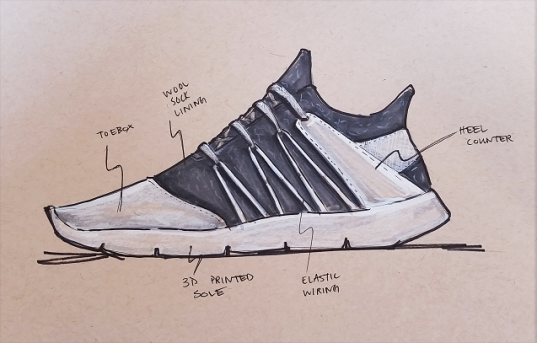A modular footwear solution that reduces the amount of waste in the environment
Winner of the “Best Student Project” category in the third Cradle to Cradle Product Design challenge, Quang Pham, Virginia Tech student used Fusion 360 to create MODS, a modular shoe, in response to the millions of pairs of shoes that end up in landfills each year, where they can take 30-40 years to decompose. MODS shoes can be customized and updated as the shoe deteriorates without using glue and made with recyclable and sustainable materials.
Autodesk Software Used:
Challenge Summary
The goal of the Cradle to Cradle Design Challenge was to eliminate the concept of “waste” by designing products with materials that may be perpetually cycled to retain their value as nutrients to fuel growing global economies.
Design Summary
MODS was designed as a modular shoe that can be customized and updated as the shoe deteriorates. It consists of 5 modular units that are the minimal amount of material needed for maximum comfort and security, and are made from three homogeneous materials, which are essentially 100% recyclable:
- Wool used for the inner sock lining is a great insulator and naturally wicks away moisture.
- Bamboo is used for the toe box and elastic wires and bands.
- Polyethylene Terephthalate (PET) used in the shoe sole and heel counter is 3D printed through converting water bottles and ocean plastics into a 3D filament.
The customer is able to customize his shoe and adjust the sole to fit his needs. The modular shoe is worn to fit the users’ needs; can be disassembled for easy cleaning; and can be interchanged with other parts.
Autodesk Fusion 360
After separating soles from old shoes, Fusion 360 was used to model a running shoe sole that was thin and flexible while still allowing cushion. Using the Sculpt mode was especially helpful. Fusion 360 allows the freedom to sculpt a shape that designer Quang really wanted and was able to edit minor details without changing the whole form too much.
After finishing the CAD model, Quang 3D printed a section of the sole and saw that he could change the wall thickness and inlay densities. This allows for customization of the soles density.
Footwear culture has progressed and 3D printing technology has exponentially advanced. Having an adaptable program helped Quang tie these two things together to make this project possible.

| Attachment | Size |
|---|---|
| 5.41 MB |

